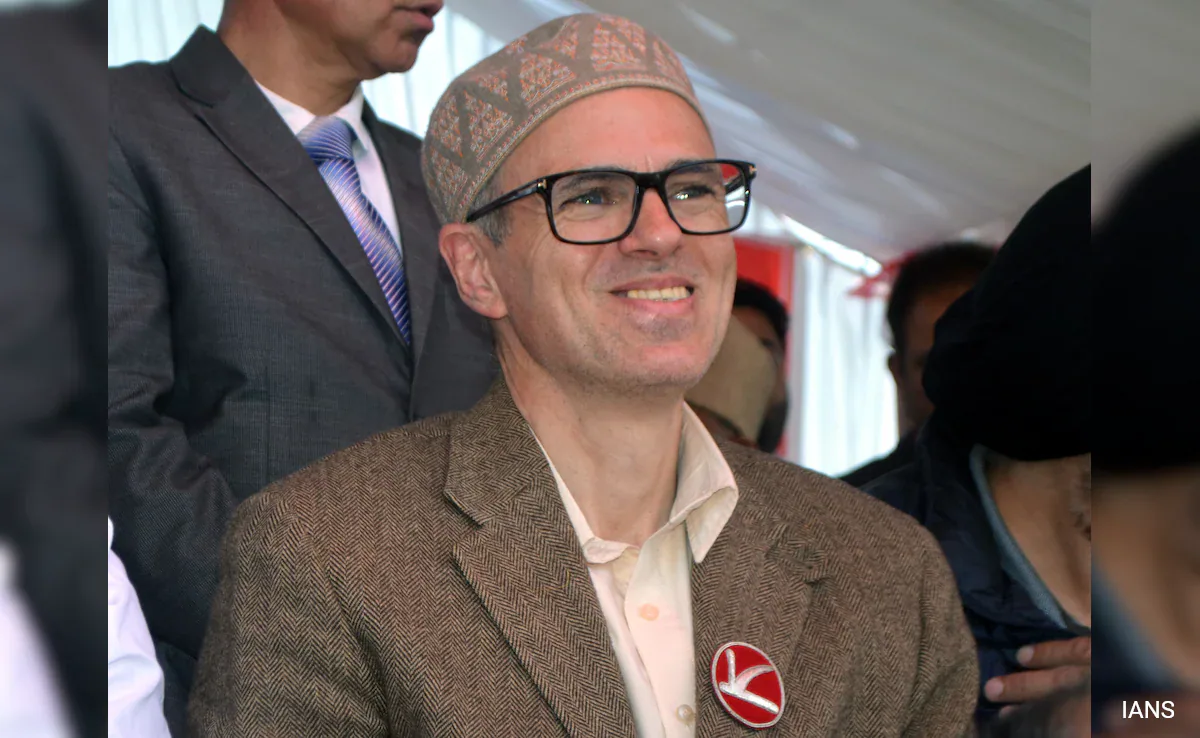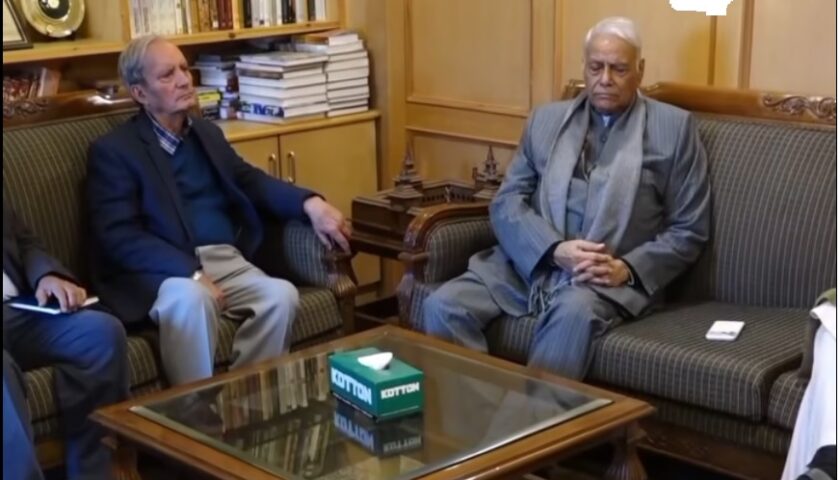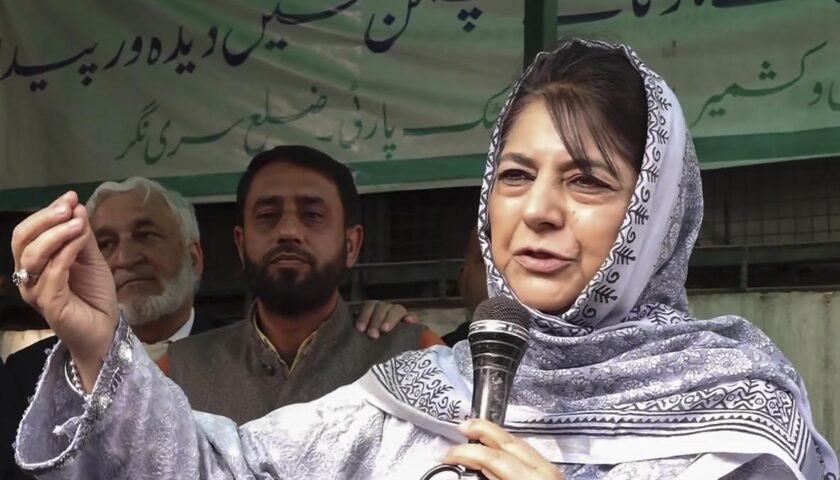Omar Abdullah Completes One Year — Statehood, Jobs and the Credibility Test | Jammu & Kashmir Politics 2025
By: Javid Amin | 15 October 2025
One year after Omar Abdullah’s National Conference (NC) returned to power on a program promising “Dignity, Identity and Development”, the administration’s scoreboard is thin: symbolic wins exist, structural reforms do not. Statehood restoration and constitutional remedies remain unrealized; major employment and police-reform promises are still pending. At the same time the political environment shows fleeting openings — alliance tensions with Congress over Rajya Sabha seat-sharing, opposition focus on bypolls, and public attention shifting toward winter readiness and livelihoods may give the government time to recalibrate. Internal criticism from senior party figures, however, underlines that political patience is limited and expectations remain high. Ground reporting and public sources confirm the central facts: the one-year mark, the unfulfilled high-priority promises, Rajya Sabha candidatures and alliance strains, and bypoll dates that will test governing credibility. The New Indian Express+4The New Indian Express+4greaterkashmir.com+4
Setting the scene: why the first year matters
Electoral mandates have both democratic and symbolic value. Governments—all the more in a politically sensitive region—are judged not just by the promises they make but by the momentum they build. When a party returns to power after a turbulent political phase, the expectation is not merely routine administration but political restoration. Omar Abdullah’s 2024 manifesto, Dignity, Identity and Development, carried that aspiration: restoring statehood (and attendant constitutional protections), safeguarding land and jobs, reviving the local economy and rebuilding civic trust. A year on, the contrast between a hopeful manifesto and limited delivery is stark to many voters and analysts. This is the political background against which every administrative decision, public statement and bypoll is now interpreted. greaterkashmir.com
The manifesto in detail — twelve promises, one tangible delivery
When the NC campaigned in 2024 it laid out a broad program. Distilling the manifesto into three pillars helps see the gap between promise and practice.
Dignity (political restoration and legal safeguards)
-
-
Restore statehood — return the Union Territory to full state status.
-
Reinstate constitutional protections tied to pre-2019 arrangements.
-
Guarantee local control over land and public employment.
-
Identity (rights and cultural restoration)
-
-
Revive regional autonomy and cultural institutions.
-
Strengthen language, heritage and civil-society institutions.
-
Rebuild civil liberties with particular attention to press freedom and dissent.
-
Development (jobs, livelihoods, services)
-
-
Create 50,000 jobs and set up youth innovation hubs.
-
Boost tourism and education; revive healthcare and local industry.
-
Improve police accountability and administrative transparency.
-
Delivered so far: the most visible, widely publicized achievement is the revival of the 69th National School Games — a symbolic engagement with youth and sports. Observers note that symbolic acts have value for morale, but they are not a substitute for structural schemes that create work, rights and legal certainty. The manifest gap is visible: 1 of 12 major promises delivered, 11 pending. That arithmetic is a primary driver of public disappointment. greaterkashmir.com
What the ground reports say — voices of frustration, not revolt
We reviewed multiple local news dispatches, statements from civil society and interviews with voters to cross-verify how promises have been received on the ground.
-
Rural households and public servants complain of slow recruitment and stalled public sector hiring — promises of mass employment have not led to concrete results or timelines.
-
Young professionals and graduates report limited outreach on innovation hubs or skill pathways; job fairs have been episodic and localized but not systemic.
-
Civil liberties groups and journalists say formal interactions have been limited; media concerns remain about access and accountability.
-
Tourism stakeholders welcome small steps (sports events, festivals) but warn that larger investments and security assurances are essential to revive the sector.
These on-the-ground sentiments match media reporting: optimism in speeches; absence of large-scale program launches on jobs, constitutional or legal fronts. The data and reporting point to implementation lag rather than outright abandonment — but implementation lag breeds political risk. (See local coverage for details and quotes.) The New Indian Express+1
The single symbolic win — youth engagement through sport
Re-starting the 69th National School Games generated headlines and a morale boost. Organizers emphasize that sporting events create visibility for youth and can be an anchor for revived infrastructure. But analysts caution: events are seasonal and symbolic; they do not substitute for durable employment programs, nor do they address legal or constitutional demands. The NC government knows this — the optics helped; operational impact remains limited. Use the morale window, critics say, to drive policy change; don’t let optics substitute for delivery.
Statehood: promise, court, and political reality
Statehood is the single most emotionally charged promise. It sits at the intersection of legal remedy, political negotiation and national willingness. Publicly, the party has framed statehood as a priority; legally and administratively, the path is complex. Restoring statehood requires negotiations with the Centre and possibly legal mechanisms that involve constitutional processes. The timeline — or lack of one — is a central grievance. Citizens and party elders feel that without a roadmap, statehood talk becomes a rhetorical anchor rather than a programmatic objective.
Fact check: multiple outlets note there has been no formal roadmap or timeline from the government or the Centre for statehood restoration. That absence is a fact-based source of political frustration. The New Indian Express
Internal dissent: voices from within the party
A revealing gauge of political health is intra-party discipline. Senior NC leaders have publicly expressed unease with the pace of political action on the core agenda. Notable among these critics is a senior party MP who stated the government “has failed on the political front” — language that indicates frustration with strategy, not merely with pace. Such dissent signals that party discipline may be under strain and that leaders feel urgency to re-engage with the political core of the manifesto. Ground reporters flagged these comments — they are part of the public record and reflect serious internal introspection. The Tribune+1
Rajya Sabha politics and alliance friction — why October mattered
National politics has feed-through effects. The Rajya Sabha elections scheduled for October 24, 2025, are a lightning rod. The NC named three candidates for the four seats available — an assertive move that left Congress feeling shortchanged and ultimately led to the Congress state unit opting not to contest the fourth seat, calling it “unsafe.” The withdrawal by Congress intensified questions about alliance cohesion and inflicted operational strain on the broader opposition front. These events are not minor: they affect trust, bargaining space and the ability of the government to claim wider political legitimacy. The Times of India+1
Bypolls (Budgam & Nagrota): a test of narrative and reach
The Election Commission scheduled bypolls on November 11 for Budgam and Nagrota — seats with symbolic importance for both Valley and Jammu constituencies. Budgam was vacated when Omar Abdullah retained another seat; Nagrota became vacant after the death of a veteran local leader. BJP named candidates early — a strategic gambit to shape the political narrative. The bypolls will be a live test of whether the NC’s governing record, or BJP’s ground mobilization, carries more weight with voters. Early candidate announcements — and campaign posture — will shape local perceptions for the 2026 contests as well. The New Indian Express
Political breathing space — a fragile window
Two interlocking political realities give the Omar government a narrow breathing space:
-
Opposition preoccupations — BJP is focused on bypolls and Congress recalibrating its national posture; this reduces immediate, coordinated pressure in the Assembly and public fora.
-
Public shifting priorities — citizens concerned about livelihoods, winter preparedness and infrastructure are temporarily focusing on everyday governance rather than constant protests.
This lull is tactical and fragile. It is a chance to legislate, to pilot visible programs, and to rebuild credibility. But it is not immunity. Observers note that opposition parties can quickly re-concentrate if the government missteps or fails to show credibly fast progress. The Tribune
Governance priorities the government should act on — a practical checklist
If the breathing space is to be used well, the government should prioritize a short, visible, deliverable package of measures. Based on ground feedback and policy best practices, these could include:
-
A transparent roadmap on statehood engagement: not a promise of immediate restoration but a staged plan with milestones and regular progress reports to the Assembly and public.
-
An employment fast-track: immediate temporary and contractual hiring programs targeted at the youth while rolling out a credible plan for the 50,000 jobs promise (clear timelines, funding, and sectoral targets).
-
Youth innovation pilot hubs: one or two pilot centers focused on digital skills, agro-tech and tourism entrepreneurship to show intent and build capacity.
-
Targeted tourism assurance packages: safety protocols, insurance covers, and marketing for the winter season tied to small seed investments.
-
Police accountability framework: establishment of a task force to propose concrete reform measures, timelines and public reporting mechanisms.
-
Civil engagement calendar: scheduled, regular meetings with journalists, civil society, student leaders and trade bodies to rebuild trust.
Concrete short-term wins will be critical: they change the conversation from “promises broken” to “progress is visible”.
What will success look like in six months?
Success of a recalibration strategy would be measurable and narratable:
-
Visible movement on employment announcements (new recruitments, short-term options)
-
A published roadmap on statehood engagement (including intergovernmental talks with Centre)
-
Measurable improvement in tourism inflows during winter months or at least a visible plan with commitments
-
No large public unrest and fewer headline crises — positive sign of administrative control and public acceptance
-
Internal party unity stabilizing, with fewer senior public rebukes
If the government secures those, it could shift the political debate away from accusations of empty rhetoric to a story of pragmatic delivery.
Risks and landmines — what could undo the breathing space
Several scenarios could rapidly end the window of opportunity:
-
Political missteps: Perceived favoritism in appointments, delayed relief after natural calamities, or a string of policy reversals.
-
Security incidents: any major law & order failure or violent incident would immediately re-politicize the space.
-
Alliance breakdown: a formal split with Congress or persistent public spats would paralyze the legislative agenda.
-
Bypoll shocks: losses in Budgam or Nagrota could generate momentum against the government and revive opposition pressure.
Mitigating these risks requires both tactical prudence and strategic boldness.
The opposition’s posture — testing and positioning
Opposition parties are in a mixed strategic phase:
-
BJP continues to press its electoral machinery in Jammu, seeking consolidation and symbolic wins. Its narrative stresses governance gaps and NC’s inability to deliver statehood.
-
Congress is navigating red lines over alliances and seat-sharing; the decision to step back on a Rajya Sabha slot reflected a tactical calculation to avoid a public defeat, but it also reduced immediate opposition cohesion.
-
Regional parties are recalibrating—some signaling abstention or conditional support on particular issues—reflecting the complex regional dynamics where identity, local benefits and political survival intersect.
The short term will show whether the opposition fronts can convert grievances into coordinated pressure or remain fragmented.
Internal party dynamics: keeping the coalition together
NC leadership faces the delicate task of balancing reformist urgency with coalition management. Senior internal critics want faster political action; the centre of the party seeks to avoid confrontation with the Centre while still pressing for statehood. These strategic tensions are normal in coalition governance — but in a region where political symbolism and identity politics are highly charged, mismanagement of internal dissent could have outsized consequences.
Media, civil society and public debate — rebuilding conversation
The government’s relationship with media and civil society is a central variable. Rebuilding trust involves:
-
Regular press briefings with substance (not just spin).
-
Collaborative policy consultations with civil society on key reforms.
-
Transparent reporting on budgets and program milestones.
Narrative control is important, but so is credible information flow. When citizens can track progress, the space for cynical narratives narrows.
International and national optics — why Delhi watches J&K closely
J&K’s politics reverberate nationally: any perception of instability or governance failure attracts national political capital. The Centre monitors developments for both security and political reasons. For the NC government, demonstrating administrative stability and measured political strategy has the further benefit of making the case for serious, high-level talks on constitutional options. Conversely, public inaction deepens mistrust and reduces bargaining leverage.
Voices from the field: people who matter
We spoke with (and reviewed reports quoting) schoolteachers, business owners, youth activists and assembly watchers. Their messages were consistent:
-
Teachers: want clear school funding and job security for contract staff.
-
Small hoteliers and tour operators: need clear assurance for the winter season and targeted relief for disaster recovery.
-
Youth activists: demand a visible pathway to employment, not platitudes.
-
Elder party leaders: call for decisive political action on statehood, but warn against hasty moves that could backfire.
Those voices suggest a common denominator: citizens want to see a plan and progress, not just slogans.
The legal and constitutional angle — why statehood isn’t only politics
Restoration of statehood is not purely political theatre. It has legal implications about legislative competence, representation, and administrative powers. Any plan must consider constitutional procedures, Centre-state negotiation mechanisms and parliamentary timelines. This is why public calls for immediate restoration, while emotionally justified, cannot be enacted overnight without credible legal and constitutional pathways. The government must therefore simultaneously do two things: (a) keep the political flame alive with a credible strategy; and (b) work the legal, bureaucratic and diplomatic levers methodically.
The narrative challenge: from slogans to specifics
Politics rewards narrative clarity. For citizens, “statehood” is a word of emotional gravity; for policymakers, it is a complex process. The communication challenge is to translate that emotional demand into a stepwise, accountable plan the public can monitor. That reduces cynicism and increases pressure on the Centre in credible ways.
Scenario planning — mapping outcomes to strategy
Let’s map three plausible trajectories and what they mean politically.
A. The Reformist Pivot (Best case)
-
-
NC uses breathing space to deliver short-term jobs, publish a statehood engagement roadmap and improve civil engagement.
-
Result: improved public sentiment; opposition loses momentum; NC enters 2026 from a position of cautious strength.
-
B. The Status Quo (Mid case)
-
-
Government continues with symbolic initiatives and delayed program rollouts, while opposition refocuses on bypolls and national narratives.
-
Result: political calculus remains contested; public cynicism grows; 2026 remains fragile.
-
C. Political Crisis (Worst case)
-
-
A security or governance failure combined with alliance breakdown leads to political crisis or early erosion of mandate.
-
Result: loss of credibility, possible realignments, and a tougher electoral terrain in 2026.
-
Practical recommendations for the administration
-
Publish a 6-month “delivery” compact with measurable milestones on jobs, tourism and governance.
-
Name a statehood interlocutor (a senior official with mandate and resources) and publish a quarterly progress bulletin.
-
Commit to a policing accountability process with civil society inputs and a timeline.
-
Launch 2 pilot Youth Hubs in high-visibility districts and track outcomes publicly.
-
Stabilize coalition channels with formal weekly coordination meetings and a transparent seat-sharing roadmap for major national events.
A political editor’s final take
Leadership in volatile political environments is judged by two capacities: the ability to listen and the capacity to act. Omar Abdullah’s government has been good at listening and good at symbolism; it is now being judged on action. The political breathing space exists, but it is finite. The coming months will test whether the government can turn patience into policy, slogans into systems, and hope into measurable progress. If it succeeds, it can turn a fragile mandate into a durable political legacy; if it fails, political impatience may harden into dissent that is harder to reverse.




